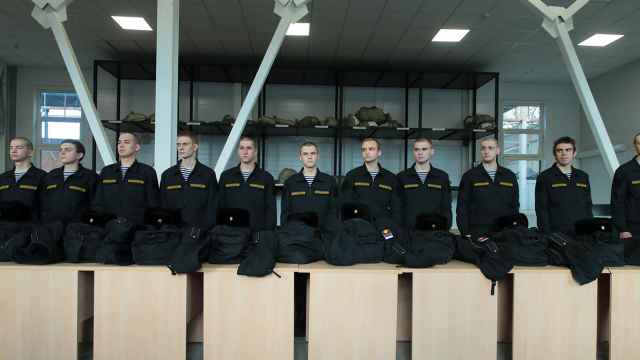TOSNO, Leningrad Region — U.S. engineering giant Caterpillar launched in-country production of mining trucks in a bid to capitalize on a boom in metals and mining across the former Soviet Union, executives said.
“This isn’t an investment with a five- or seven-year time frame — it’s an investment for the next 25 or 30 years,” group president Steven Wunning told The Moscow Times in an interview at the company’s plant in Tosno, Leningrad region, late last week.
“Most of the world’s population now lives in cities, and the population of the world is set to grow by about 6 million a year for at least the next 30 years. The demand that is going to place on mining, which provides the raw materials for building housing, infrastructure, supplying clean water and other things that make cities work, is vast,” Wunning said.
The new truck, the 55-ton-payload 773-E, which went into production late last week, is a vast, six-wheeled monster that will be sold to extractive industries across the country.
Mumin Azamkhuzhaev, general director for Caterpillar Eurasia, told reporters the plant will be able to produce up to 300 trucks a year. The company already has a “horizon to sell all of the trucks produced in the first year,” many to mining operations in Mongolia, he added.
Caterpillar has invested a total of about $100 million in the Tosno plant, its flagship production facility in Russia established in 2000.
It invested about $10 million in setting up production of the 773-E, which will be the third Caterpillar model to be produced at the factory.
In 2008, the factory began to turn out 27-ton excavators — Caterpillar’s first Russian-produced vehicles. In January this year, the company launched production of a larger, 35-ton earth mover.
The chassis of the 773-E is built at the Leningrad region plant, while the body is assembled at a plant in Novosibirsk. Other components, including engines, electronics and hydraulics, are imported from Caterpillar factories in the United States and Europe. There are no plans to localize that production in the foreseeable future.
While the company boasted about “localization of production,” Azamkhuzhaev refused to put a percentage on how localized the company has become — a practice common in the auto industry, where the federal government has provided incentives for companies that can prove a certain level of localized production.
No such incentives were on offer for the production of mining trucks or excavators, Azamkhuzhaev said.
Group president Steven Wunning confirmed to The Moscow Times that the decision to start production of the 773-E was motivated primarily by the financial benefits of being closer to customers. “There were no incentives offered to us to do this,” he said.
Instead, the main motivation is to get closer to customers in a bid to cut delivery costs and provide better after-sales maintenance — a key part of the appeal of Caterpillar’s relatively expensive products.
The Russian mining industry has traditionally been served by Belarus’ BelAZ, whose heavy vehicles continue to dominate the market.
Caterpillar’s vehicles are more expensive to buy and maintain than BelAZ’s, but the American company is betting that a longer service lifetime and fewer repairs make its vehicles the most cost-effective option in the long term.
That logic does indeed make Caterpillar and Japan’s Komatsu more competitive for those who can afford them, said Nikolai Sosnovsky, a metals and mining analyst at UralSib.
“It depends on your financial abilities. Big companies definitely can afford expensive mining machinery. But smaller producers will use BelAZ — unless they can raise the money via credit at a decent rate,” he told The Moscow Times.
The 773-E trucks cost “around about” $700,000 each, Wunning said, though he emphasized that this rule-of-thumb figure varies widely depending on customization and negotiation between dealers and customers.
The company is likely banking on the coal and precious-metals industries — both of which are set for large-scale expansion in the coming years.
“If you take the coal industry alone, a massive expansion is planned — about 30 percent, or 100 million tons of coal,” Sosnovsky said.
And a shift from the alluvial gold that Russia has traditionally mined to hard-rock deposits means the development of “big open pits with lots of trucks and processing plants,” Sosnovsky said.
“If you look at several projects planned in Russia by big gold producers, they’re going to require hundreds of trucks,” he said.
Nonetheless, although Caterpillar may corner a slice of the market, it is unlikely to dislodge BelAZ, which offers at least 10 different models of rock hauler, from its dominant position in the CIS in the near future.
“We want to walk before we run,” said Wunning, when asked if other models would be built at Tosno.
A Message from The Moscow Times:
Dear readers,
We are facing unprecedented challenges. Russia's Prosecutor General's Office has designated The Moscow Times as an "undesirable" organization, criminalizing our work and putting our staff at risk of prosecution. This follows our earlier unjust labeling as a "foreign agent."
These actions are direct attempts to silence independent journalism in Russia. The authorities claim our work "discredits the decisions of the Russian leadership." We see things differently: we strive to provide accurate, unbiased reporting on Russia.
We, the journalists of The Moscow Times, refuse to be silenced. But to continue our work, we need your help.
Your support, no matter how small, makes a world of difference. If you can, please support us monthly starting from just $2. It's quick to set up, and every contribution makes a significant impact.
By supporting The Moscow Times, you're defending open, independent journalism in the face of repression. Thank you for standing with us.
Remind me later.






